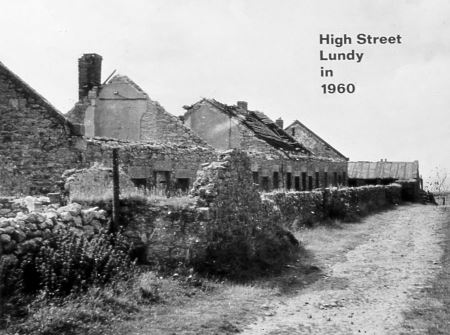History since 1969 – the Landmark Trust era
 The National Trust were encouraged to take on Lundy by John Smith (later Sir John) who was the founder-Chairman of the Landmark Trust and a board member of the National Trust. Landmark took Lundy on a 60-year, full repairing lease, with the aim – in John Smith's words in the 1970 Landmark Handbook – “to make and keep Lundy a tranquil, solid and unaffected place with a life of its own”.
The National Trust were encouraged to take on Lundy by John Smith (later Sir John) who was the founder-Chairman of the Landmark Trust and a board member of the National Trust. Landmark took Lundy on a 60-year, full repairing lease, with the aim – in John Smith's words in the 1970 Landmark Handbook – “to make and keep Lundy a tranquil, solid and unaffected place with a life of its own”.
When Landmark took over, there was a lot to do. There has been a tremendous amount of 'development' of the island to bring it up to modern standards and to make the buildings available for self-catering accommodation. But 'development' is in very heavy inverted commas – the ethos of the Landmark Trust is to make their properties sympathetic to their original design. In 1971 work started on Millcombe House, and in 1983 restoration of the old Manor Farm Hotel buildings culminated in the opening of an enlarged Marisco Tavern. In that period, a dozen buildings were extensively restored, others modernised in minor ways and one new one was built – Government House.
 As well as the buildings, all the infrastructure needed modernisation and expansion to meet the needs of the visitors who would provide Lundy's future income. Again, in John Smith's words, “... most things on the island were wearing out, and, although it was exceedingly agreeable in that state, if the island was to remain inhabited and receive visitors, a great deal of expensive, unromantic and disruptive work had to be done”. That work included water supply, drainage and power supplies. Between 1982 and 1996 an aerogenerator stood in Lighthouse Field to supplement the diesel-generated electricity. The problem on Lundy was too much wind, not too little, and the aerogenerator was removed after being blown over several times.
As well as the buildings, all the infrastructure needed modernisation and expansion to meet the needs of the visitors who would provide Lundy's future income. Again, in John Smith's words, “... most things on the island were wearing out, and, although it was exceedingly agreeable in that state, if the island was to remain inhabited and receive visitors, a great deal of expensive, unromantic and disruptive work had to be done”. That work included water supply, drainage and power supplies. Between 1982 and 1996 an aerogenerator stood in Lighthouse Field to supplement the diesel-generated electricity. The problem on Lundy was too much wind, not too little, and the aerogenerator was removed after being blown over several times.
The ship which the Harmans had used to supply Lundy, the 'Lundy Gannet', was a former fishing vessel and not up to the job of transporting significant amounts of freight, so Landmark acquired a sturdy vessel from the Danish government. Renamed the 'Polar Bear' she was a reliable carrier of goods, but was limited, like the 'Lundy Gannet', to carrying only 12 passengers. After a search throughout northern Europe for a suitable passenger vessel, MS Oldenburg was acquired in 1985 and made her first passenger trip in May 1986, having been refitted according to Department of Transport regulations.
Like all her predecessors, the 'Oldenburg' was obliged to trans-ship both people and freight to smaller vessels for arriving on Lundy's Landing Beach. The final major piece of infrastructure, the jetty, was completed in late 1999.
 On 15 May 2010, the former flag of Lundy which had been adopted by the Harman family – a white 'L' on a blue field – was revived and hoisted by Diana Keast, the younger daughter of Martin Coles Harman, as part of celebrations to mark 40 years of National Trust ownership and Landmark Trust management of Lundy. This flag is flown from time to time on special occasions.
On 15 May 2010, the former flag of Lundy which had been adopted by the Harman family – a white 'L' on a blue field – was revived and hoisted by Diana Keast, the younger daughter of Martin Coles Harman, as part of celebrations to mark 40 years of National Trust ownership and Landmark Trust management of Lundy. This flag is flown from time to time on special occasions.
In a major development in the island’s ecclesiastical history, Lundy became a parish in its own right in December 2013. This came about in order to facilitate repairs to St Helen’s church and its development as 'St Helen's Centre' – a multipurpose space to be used for study, research and educational purposes as well as for traditional church use.
Lundy keeps evolving and its history continues ...
Text by André Coutanche
